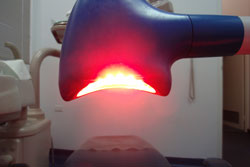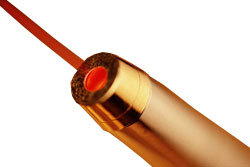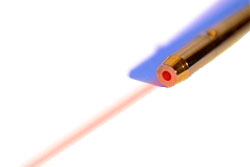- What are lasers?
- Why are lasers used?
- How using a laser can affect your health
- Who is at risk from lasers?
- Laws and regulations controlling the use of lasers
What are lasers?
Light Amplification by Stimulated Emission of Radiation, or Laser, is an instrument which generates and emits a high intensity beam of light.The light generated by a laser is produced by nuclear mechanisms (mechanisms which generate energy within the cell). It has a number of unique and desirable characteristics (e.g. the intensity of the light rays), but it also poses a health risk.
Light emitted from a laser encompasses a range of wavelengths the light spectrum and includes:
- Ultraviolet light or light rays with a wavelength 85-400 nanometres which are not visible to the human eye. Ultraviolet light is the component of sunlight which is dangerous to human skin and causes skin cancer;
- Optical light or light that is visible to the human eye with a wavelength of 400-750 nanometres; and
- Infrared light or light rays with a wavelength of 750 nanometres- 1 micrometre).
It is the ultraviolet light emitted by lasers which is associated with numerous health risks.
However, there are a large variety of lasers, used for a range of purposes, which vary considerably in the power of their output, the type of light rays that they emit (some produce ultraviolet light while others do not). Therefore, the health hazards associated with various types of laser vary considerably.
In Australia, lasers are grouped into seven categories, under the Australia and New Zealand Standard 2211.1:2004. In the relative order of health risk (from lowest to highest), these categories are 1, 1M, 2, 2M, 3R, 3B and 4.
Why are lasers used?

- Argon fluoride laser: is a UV-C emitting laser, used for corneal refractive surgery; and
- Far ultraviolet laser: is a laser emitting UV rays 193 nanometres in length, which is commonly used for ablation (removing damaged tissue) surgery.
Lasers are also commonly used in the construction industry, and the purposes for which they might be used include:
- Helium-Neon Laser: is a non-UV emitting laser, which produces a pencil thin beam. It is commonly used in surveying and construction to assist in the precise alignment of objects; and
- Carbon dioxide Lasers: are commonly used for precise cutting of metal and steel.
Lasers may also be used in everyday environments for example:
- Supermarket scanners;
- Presentation pointers; and
- Devices which produce holograms.
How using a laser can affect your health

Thermal damage is the type of tissue damage most commonly associated with laser use and accidental skin contact. The damage results from the sharp increase in temperature which occurs when the skin is exposed to a laser beam and must absorb the laser energy. Thermal damage is typically associated with lasers in the optical and infrared light spectrums, and exposure time > 10 microseconds.
Photochemical reactions are the changes skin cells undergo when they are exposed to ultraviolet light. These photochemical reactions can lead to carcinogenic changes in the skin cells, and thus represent the first stage in the formation of cancerous tumours. Lasers which emit light in the ultraviolet spectrum are associated with photochemical reactions, however typically exposure must occur for > 10 seconds for photochemical reactions to be induced.
Eyes can become damaged when exposed to light rays in the ultraviolet-infrared spectrum. Ultra-violet radiation exposure typically induces damage to the eye’s surface, and conditions associated with ultraviolet exposure include cataract, kerra-conjunctivitis and other irritations and squamous cell carcinoma of the eye. Optical and ultra-violet light on the other hand typically affect the eye’s retina. In particular exposure to these light forms is associated with retinal spots arising from burns. The severity of these is highly dependent on the size of the laser beam to which the eye was exposed, with larger beams inducing greater damage.
Who is at risk from lasers?

- Craftspeople;
- Engineers;
- Doctors;and
- Other health professionals including ophthalmologists.
Laws and regulations controlling the use of lasers
In Australia, the use of UV emitting lasers is regulated by AS/NZS2211.1:1996.The use of lasers in healthcare is further regulated by the AS/NZS 4173: Guide to the safe use of lasers in health care, while laser use in the construction industry must also comply with AS 2397: Safe use of lasers in the building and construction industry.
These guidelines outline the purposes for which lasers should be used, engineering (e.g. barriers) and administrative (e.g. signage) controls which should be put in place in environments where lasers are used, and also requirements for protective clothing and accessories for laser users. Users should be trained in safety measures relevant to the use of lasers, and are thereafter bound by the Workplace Health and Safety Act 1995, to implement sufficient protective measures to protect themselves from lasers.
There is also further legislation governing the use of Class 4 lasers used for treating patients, outlined in the Radiation Safety Act and Regulation 1999.
References
- United States Government Occupational Health and Safety Association. Laser Hazards. 2008. [cited 2010, October 15]. [URL Link]
- Occupational Safety and Health Administration United States Department of Labor Washington. Guidelines for Laser Safety and Hazard Assessment. 1991. [cited 2009, April 1]. [URL Link]
- The University of Queensland. Laser Safety Guidelines. Occupational Health and Safety Unit. 2006. [cited 2010, October 15]. [URL Link]
- Vecchio P, Hietanen M, Stuck BE, et al. Protecting Workers from Ultraviolet Radiation. International Labour Organisation and World Health Organisation. 2007. [cited 2010, October 15]. [URL Link]
- Linsker R, Srinivasan R, Wynne JJ, et al. Far ultraviolet laser ablation of atherosclerotic lesions. Lasers Surg Med. 2005; 4(2): 201-6. [Abstract]
- Yilba B, Yilba Z. Effect of plasma on CO2 laser cutting. Optics Laser Engineer. 1988; 9(1): 1-12. [Abstract]
- Australian Cancer Council. Eye Protection from Ultraviolet Radiation. 2006. [cited 2010, October 15]. [URL Link]
- Australian Radiation Protection and Nuclear Safety Agency. Radiation Protection Standard: Occupational Exposure to Ultraviolet Radiation. 2006. [cited 2010, October 15]. [URL Link]
All content and media on the HealthEngine Blog is created and published online for informational purposes only. It is not intended to be a substitute for professional medical advice and should not be relied on as health or personal advice. Always seek the guidance of your doctor or other qualified health professional with any questions you may have regarding your health or a medical condition. Never disregard the advice of a medical professional, or delay in seeking it because of something you have read on this Website. If you think you may have a medical emergency, call your doctor, go to the nearest hospital emergency department, or call the emergency services immediately.








